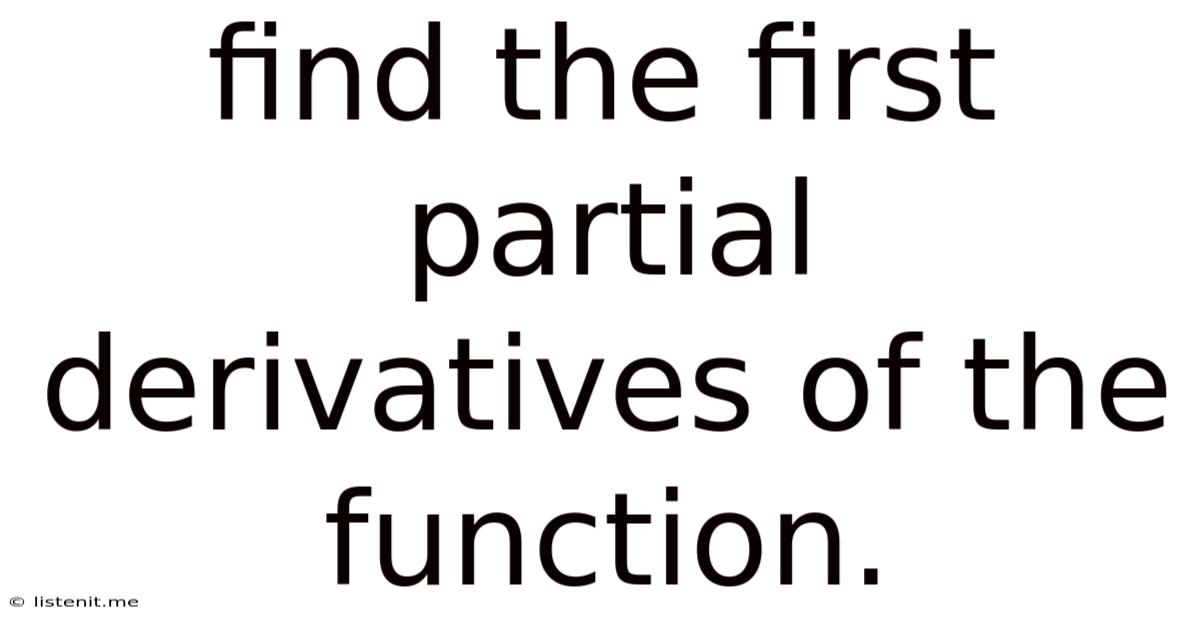Find The First Partial Derivatives Of The Function.
listenit
May 12, 2025 · 4 min read

Table of Contents
Finding the First Partial Derivatives of a Function: A Comprehensive Guide
Finding partial derivatives is a fundamental concept in multivariable calculus. This comprehensive guide will delve into the process, explaining the theory behind it and providing numerous examples to solidify your understanding. We'll cover various functions, including those involving multiple variables and different mathematical operations. By the end, you'll be confident in calculating first partial derivatives and understanding their significance.
Understanding Partial Derivatives
Unlike ordinary derivatives which deal with functions of a single variable, partial derivatives deal with functions of multiple variables. Imagine a surface defined by a function, z = f(x, y). A partial derivative tells us the instantaneous rate of change of the function with respect to one variable, while holding all other variables constant. Think of it like "slicing" the surface with a plane parallel to one of the axes and then finding the slope of the resulting curve.
Key Differences from Ordinary Derivatives
-
Multiple Variables: The core difference lies in the number of independent variables. Ordinary derivatives involve a single independent variable, whereas partial derivatives handle multiple.
-
Holding Variables Constant: When calculating the partial derivative with respect to one variable (e.g.,
x), we treat all other variables (e.g.,y,z) as constants. -
Notation: Partial derivatives are denoted using the symbols ∂ (a stylized "d") instead of "d" used in ordinary derivatives. For example, the partial derivative of
f(x, y)with respect toxis denoted as ∂f/∂x or f<sub>x</sub>.
Calculating First Partial Derivatives
The process of calculating first partial derivatives is similar to finding ordinary derivatives, but with the crucial step of treating other variables as constants. Let's illustrate this with examples:
Example 1: Polynomial Functions
Let's consider the function f(x, y) = 3x² + 2xy + y³.
To find the partial derivative with respect to x, ∂f/∂x, we treat y as a constant:
∂f/∂x = 6x + 2y
Similarly, to find the partial derivative with respect to y, ∂f/∂y, we treat x as a constant:
∂f/∂y = 2x + 3y²
Example 2: Functions with Exponential and Trigonometric Terms
Let's consider a more complex function: g(x, y) = e^(xy) * sin(x).
For ∂g/∂x, we use the product rule and treat y as a constant:
∂g/∂x = ye^(xy)sin(x) + e^(xy)cos(x)
For ∂g/∂y, we treat x as a constant:
∂g/∂y = xe^(xy)sin(x)
Example 3: Functions with Multiple Variables
Consider the function h(x, y, z) = x²yz + ln(x) + y²z³.
Finding the partial derivatives:
∂h/∂x = 2xyz + 1/x
∂h/∂y = x²z + 2yz³
∂h/∂z = x²y + 3y²z²
Example 4: Implicit Differentiation
Sometimes, functions are defined implicitly. Let's say we have x² + y² + z² = 1. To find ∂z/∂x, we differentiate both sides with respect to x, treating y as a constant:
2x + 2z(∂z/∂x) = 0
Solving for ∂z/∂x:
∂z/∂x = -x/z
Higher-Order Partial Derivatives
Just as with ordinary derivatives, we can find higher-order partial derivatives. These are derivatives of the first partial derivatives. For instance, for a function f(x, y), we can find:
-
Second-order partial derivatives: ∂²f/∂x², ∂²f/∂y², ∂²f/∂x∂y (mixed partial), ∂²f/∂y∂x (mixed partial). Note that under certain conditions (Clairaut's Theorem), ∂²f/∂x∂y = ∂²f/∂y∂x.
-
Third-order and higher-order partial derivatives: These follow the same pattern, taking derivatives of the previous order derivatives.
Example of Second-Order Partial Derivatives
Let's use the function from Example 1: f(x, y) = 3x² + 2xy + y³.
-
∂²f/∂x² = 6
-
∂²f/∂y² = 6y
-
∂²f/∂x∂y = 2
-
∂²f/∂y∂x = 2 (Note: this equals ∂²f/∂x∂y)
Applications of Partial Derivatives
Partial derivatives have widespread applications in various fields:
-
Physics: Describing rates of change in systems with multiple variables (e.g., temperature, pressure, volume).
-
Economics: Analyzing marginal productivity, optimizing resource allocation.
-
Machine Learning: Gradient descent algorithms, which are crucial for training machine learning models, heavily rely on partial derivatives.
-
Computer Graphics: Calculating surface normals, creating realistic lighting and shading effects.
-
Engineering: Optimizing designs, analyzing stress and strain in structures.
Advanced Topics and Considerations
-
Chain Rule for Partial Derivatives: This is used when dealing with composite functions where variables depend on other variables.
-
Directional Derivatives: This extends the concept of partial derivatives to find the rate of change in an arbitrary direction.
-
Gradient Vector: This vector consists of all first partial derivatives and points in the direction of the greatest rate of increase of the function.
-
Hessian Matrix: A matrix containing all second-order partial derivatives. It's used in optimization problems and to classify critical points.
Conclusion
Understanding and calculating partial derivatives is a vital skill in multivariable calculus. This guide has covered the fundamental concepts, calculation techniques, and numerous examples to help you master this important tool. Remember to always treat variables other than the one you are differentiating with respect to as constants. Practice makes perfect, so work through various examples to build your understanding and confidence. By applying these techniques, you'll be able to solve various problems and tackle more advanced topics in multivariable calculus and its applications. Don't hesitate to explore further into the advanced topics mentioned to deepen your expertise.
Latest Posts
Latest Posts
-
What Is The Charge On A Chloride Ion
May 12, 2025
-
A Sphere With A Radius Of 11 In
May 12, 2025
-
How Many Electrons In Double Bond
May 12, 2025
-
What Was The Religion Of The Virginia Colony
May 12, 2025
-
Solution In Which Water Is The Solvent
May 12, 2025
Related Post
Thank you for visiting our website which covers about Find The First Partial Derivatives Of The Function. . We hope the information provided has been useful to you. Feel free to contact us if you have any questions or need further assistance. See you next time and don't miss to bookmark.